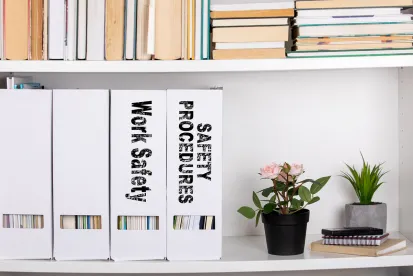On January 29, 2021, the U.S. Occupational Safety and Health Administration (OSHA) published new guidance on mitigating and preventing the spread of COVID-19 in the workplace. In a press release announcing the new guidance, OSHA declared that the new guidance is “stronger worker safety guidance” intended to inform employers outside of the healthcare industry about how to identify the risks of exposure to COVID-19 and determine the appropriate control measures for their respective workplaces.
While OSHA’s new guidance is more detailed, it does not necessarily appear to be “stronger.” According to OSHA, the new “guidance … provides additional detail on key measures for limiting the spread of COVID-19,” most of which will be familiar to employers. OSHA announced that “[t]he guidance details key measures for limiting coronavirus’s spread, including ensuring infected or potentially infected people are not in the workplace, implementing and following physical distancing protocols and using surgical masks or cloth face coverings.” The guidance also addresses “personal protective equipment [PPE], improving ventilation, good hygiene and routine cleaning.”
OSHA’s new guidance emphasizes that “[i]mplementing a workplace COVID-19 prevention program” with these and other prevention control measures is the most effective way to mitigate the spread of COVID-19 at work.” [Emphasis in original.] According to OSHA, effective COVID-19 prevention programs include the following elements:
-
“Assignment of a workplace coordinator … responsible for COVID-19 issues”
-
“Identification of where and how workers might be exposed to COVID-19 at work” by conducting a “hazard assessment”
-
“Identification of a combination of measures that will limit the spread of COVID-19 in the workplace, in line with the principles of the hierarchy of controls”
-
“Consideration of protections for workers at higher risk for severe illness through supportive policies and practices”
-
“Establishment of a system for communicating effectively with workers and in a language they understand”
-
“Educate and train workers on your COVID-19 policies and procedures”
-
“Instruct workers who are infected or potentially infected to stay home and isolate or quarantine”
-
“Minimize the negative impact of quarantine and isolation on workers,” including allowing workers to telework when possible
-
“Isolating workers who show symptoms at work”
-
“Performing enhanced cleaning and disinfection after people with suspected or confirmed COVID-19 have been in the facility”
-
“Providing guidance on screening and testing”
-
“Recording and reporting COVID-19 infections and deaths”
-
“Implementing protections from retaliation and setting up an anonymous process for workers to voice concerns about COVID-19–related hazards”
-
“Making a COVID-19 vaccine or vaccination series available at no cost to all eligible employees” and informing employees about vaccinations
-
“Not distinguishing between workers who are vaccinated and those who are not”
-
Incorporating methods to ensure compliance with other applicable OSHA standards, such as requirements for PPE and respiratory protection
While the new guidance largely reiterates and incorporates existing guidance from OSHA and the U.S. Centers for Disease Control and Prevention (CDC), there are a few new details of note. For example, OSHA now recommends that employers “[p]rovide all workers with face coverings (i.e., cloth face coverings, surgical masks)” at no cost, “unless their work task requires a respirator.” [Emphasis added.] OSHA also now recommends that employers “[r]equire any other individuals at the workplace (e.g., visitors, customers, non-employees) to wear a face covering,” with certain exceptions. Additionally, OSHA’s new guidance touches on COVID-19 vaccinations by recommending that employers make COVID-19 vaccines available at no cost to employees and that employers ensure vaccinated workers “continue to follow protective measures.”
OSHA makes clear that this new guidance is not a standard and “creates no new legal obligations” for employers. Employers are, however, required to comply with existing mandatory health and safety standards and Section 5(a)(1) of the Occupational Safety and Health Act (the General Duty Clause), which requires employers to maintain a workplace that is “free from recognized hazards.” It is conceivable that OSHA will follow this new guidance in determining whether citations to issue citations under its standards and the General Duty Clause.
The new guidance comes on the heels of President Joseph R. Biden Jr.’s direction to OSHA to issue clear guidance for employers on COVID-19 protection measures. In one of his first executive orders, President Biden stated the importance of “science-based guidance” in combatting the spread of COVID-19 in the workplace and directed the Secretary of Labor to issue revised guidance to employers on workplace safety during the COVID-19 pandemic by February 4, 2021. President Biden also ordered the Secretary of Labor to “consider whether any emergency temporary standards … are necessary,” and if so, to “issue them by March 15, 2021.”
Of course, OSHA has not yet issued an emergency standard for COVID-19 or taken other regulatory action to specifically address COVID-19. Instead, the agency has undertaken to issue guidance in piecemeal fashion, which has sparked criticism. For example, the day before OSHA issued its new guidance, the Government Accountability Office (GAO) released a report expressing concerns with OSHA’s response to the COVID-19 pandemic. Specifically, the GAO stated, “gaps in OSHA’s oversight and tracking of its adapted enforcement methods prevent the agency from assessing the effectiveness of its enforcement methods.”
At this time, it is unclear whether OSHA will adopt an emergency standard on COVID-19, but there is a high probability OSHA will eventually adopt one. According to OSHA, the agency “prepared this guidance for planning purposes” and explained that “[t]he recommendations are advisory in nature, [and] informational in content.” Employers may want to become familiar with this new guidance as OSHA may incorporate some of its components into a potential emergency standard, should the agency decide to promulgate one.




 />i
/>i
